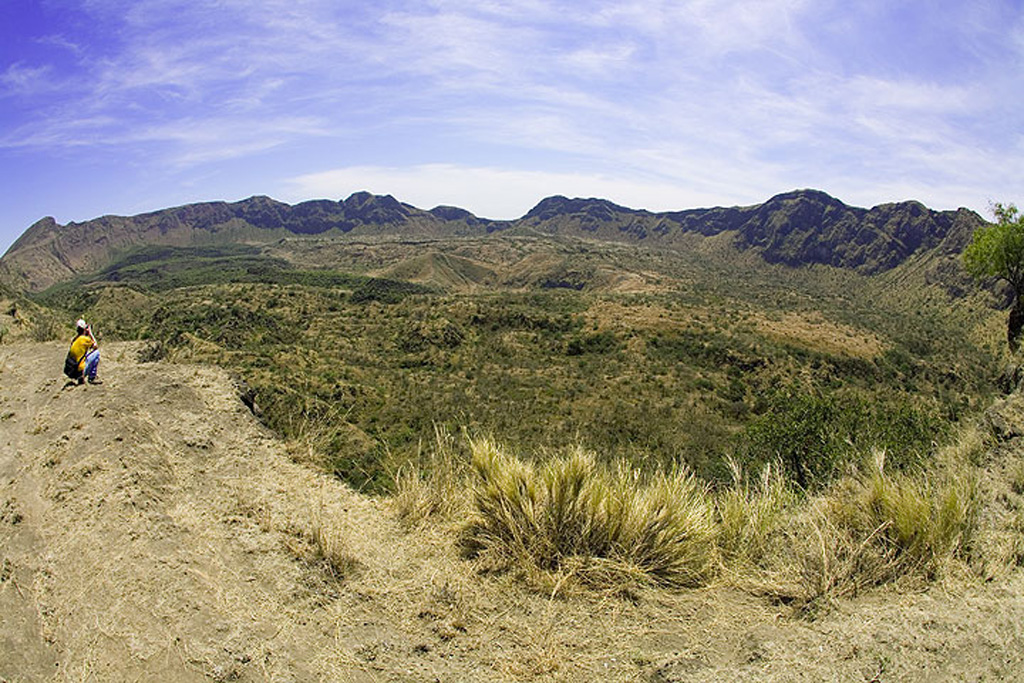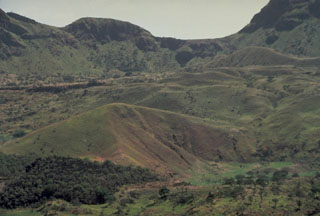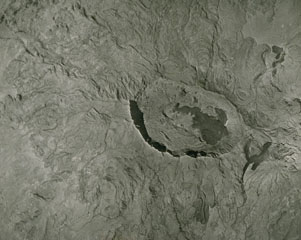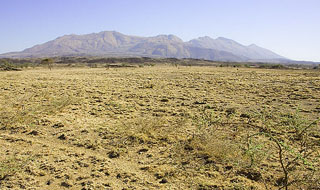

Satellite data analysis by the MIROVA team indicated that thermal anomalies over Fentale crater were visible during 13-14 January and progressively increased in size at least through 0020 on 21 January (local time). No cause of these anomalies has been identified. A visible satellite image showed a possible gas plume over the crater. A 14 January news article stated that the Fentale crater typically hosts a small lake and that billowing plumes rise above the summit. The article also noted that 10,000 people evacuated from Seganto and possibly a total of 54,000 had been evacuated from higher-risk areas. The earthquakes damaged schools, buildings, a factory, and roads.
2025: January
Satellite data analysis by the MIROVA team indicated that thermal anomalies over Fentale crater were visible during 13-14 January and progressively increased in size at least through 0020 on 21 January (local time). No cause of these anomalies has been identified. A visible satellite image showed a possible gas plume over the crater. A 14 January news article stated that the Fentale crater typically hosts a small lake and that billowing plumes rise above the summit. The article also noted that 10,000 people evacuated from Seganto and possibly a total of 54,000 had been evacuated from higher-risk areas. The earthquakes damaged schools, buildings, a factory, and roads.
Seismicity and deformation data acquired from satellite radar images indicated that a magmatic intrusion began in late September 2024 in the Afar Region between the Fentale caldera and Dofen volcano. Interferograms, which show upward and downward land movement using sequenced satellite radar data, indicated that a magmatic intrusion aligned along the central to northern part of an axis connecting these two locations began in late September 2024, according to the UK Centre for Observation and Modelling of Earthquakes, Volcanoes and Tectonics (COMET). Many felt earthquakes M 4 and above were associated with the intrusion. Data from 18 October indicated that the intrusion had slowed or paused. A second phase of the intrusion occurred during the end of 2024. An interferogram processed and interpreted by the Universitas Insan Pembangunan Indonesia (UNIPI) group in support of the Addis Abeba University showed very clear ground movement (over 40 cm of uplift) along almost the entire axis from Fentale to Dofen during 17-29 December.
Seismicity continued to be elevated in the region at least through 4 January and was likely associated with the intrusion according to the Ethiopian Geological Institute. A M 5 on 29 December located near Awash Fentale caused the collapse of more than 30 homes and cracks in roads and the ground in the Dulecha and Awash Fentale districts. On 3 January footage of increased activity at a geothermal area near Dofen was reported by news sources. The video showed water, sediment, and rocks being vigorously ejected above vents; the activity was non-volcanic in origin though it increased fears among residents that is was connected to the intrusion and potential volcanic activity. At least 10 earthquakes were recorded during 3-4 January with the largest, a M 5.8, occurring on 4 January. The Ethiopian Geological Institute reported that thousands of people had evacuated to other areas in the region.
Sources: Washington Post; The UK Centre for Observation and Modelling of Earthquakes, Volcanoes and Tectonics (COMET); Carolina Pagli, Università di Pisa; Crisis 24; Ethiopian Disaster Risk Management Commission (EDRMC); Ethiopian Geological Institute; VOA News
The Global Volcanism Program has no Bulletin Reports available for Fentale.
|
|
||||||||||||||||||||||||||
There is data available for 1 confirmed eruptive period.
1789 ± 19 years Confirmed Eruption (Explosive / Effusive) VEI: 0
| Episode 1 | Eruption (Explosive / Effusive) | Caldera floor and SW flank | ||||||||||||||||||
|---|---|---|---|---|---|---|---|---|---|---|---|---|---|---|---|---|---|---|---|
| 1789 ± 19 years - Unknown | Evidence from Observations: Reported | ||||||||||||||||||
| A fissure eruption on the S flank of the main Fentale edifice extending almost 3.5 km NE from Lake Besake through the old Tinish Sabober crater has been widely reported to have been in 1820 CE. This date is typically attributed to Gibson (1967), who remarked without specific evidence that "...perhaps as recently as 1820, a second period of...eruptions were predominantly effusive with the extrusion of a series of extensive basaltic flows from a fissure system some 4 km long." During travels in 1842, Harris (1844) wrote about Fentale that "Although the existence of thermal springs was confirmed, the volcano was unanimously represented to have emitted no smoke within the memory of the present generation." However, Harris (1844) also noted that "...the great isolated crater of Saboo [was] said to have been in full activity in the time of Sáhela Selássie's grandsire, who reigned only thirty years ago; an assertion which was fully borne out by the recent appearance of the lava streams." Siegburg et al. (2023) extensively quoted Harris (1844), noting in addition that Selassie’s grandfather, Asfaw Wossen, reigned between about 1770 and 1808 CE, which constrains the eruption to 1789 ± 19 CE. Caldera floor lavas were erupted at the same time (WoldeGabriel, 1987 pers. comm.). | |||||||||||||||||||
|
List of 2 Events for Episode 1 at Caldera floor and SW flank
|
|||||||||||||||||||
[ 1277 ± 22 years ] Discredited Eruption
No physical evidence or historical records provide support for reports of a 13th century eruption, including no known remains from the destruction of an unnamed town and church at or within Lake Besaka, as relayed by Azais and Chambard (1931). This supposed destruction was considered by Gouin (1979) to be more likely caused by human war activity. Interpretations of oral traditions likely intermix older events with more recent eruptive activity in the late 1700's, or a large earthquake, so this entry is not considered a valid eruption. From Azais and Chambard (1931, p.145, 18 Dec 1922) [translated from French]: "At Fantalé, a priest, the Alaka Wolde Caben, tells us that in the 12th century there was a church and an Abyssinian town on the present site of Lake Metahara [Basaka], engulfed by a volcanic eruption, and that the first successors of Saint Tecla Haimanot belonged to this church. The black lava of Metahara is said to date from this period." Uncited Wikipedia text (7/2025) claims that this saint did not have followers (meaning of successors?) until approximately 1255 CE, shifting the potential date range to the last 45 years of the century. From Gouin (1979, p.93): "On the main rift floor there is also evidence of recent fissural and central activity; as for instance, the lava flows on the southwestern flank [by] Sabober...reached the shores of lake Metahara (Mohr, 1962b; Gibson, 1967). Tradition has it that these flows destroyed in their path a village and its monastery (Azais and Chambord, 1931). This surge of activity is still remembered, at least by the threat that parents in the locality use to scold their naughty children: You’ll melt like the Fantale. The flows are physical evidence of the recent activity, but the destruction of the village might more objectively be attributed to war during the reign of negus Dawit (1382-1411) than to a volcanic eruption (Gebre Kaustos manuscript, Ethiopian Hagiographical Sources, National Library, Addis Ababa)."
This compilation of synonyms and subsidiary features may not be comprehensive. Features are organized into four major categories: Cones, Craters, Domes, and Thermal Features. Synonyms of features appear indented below the primary name. In some cases additional feature type, elevation, or location details are provided.
Synonyms |
||||
| Fantale | Fantalle | Fantali | ||||
Cones |
||||
| Feature Name | Feature Type | Elevation | Latitude | Longitude |
| Tinish Sabober | Tuff ring | 1079 m | 8° 56' 5.00" N | 39° 53' 16.00" E |
 The forested lava flow (left foreground) was erupted on the caldera floor of Fentale volcano in 1820. This view looks from the NE. The walls of the 3 x 4 km summit caldera are up to 500 m high. During the 1820 eruption, basaltic lava flows were also extruded onto the Main Ethiopian Rift from a 4-km-long fissure on the south flank.
The forested lava flow (left foreground) was erupted on the caldera floor of Fentale volcano in 1820. This view looks from the NE. The walls of the 3 x 4 km summit caldera are up to 500 m high. During the 1820 eruption, basaltic lava flows were also extruded onto the Main Ethiopian Rift from a 4-km-long fissure on the south flank. A vertical aerial photo of the Quaternary Fentale volcanic complex, lying along the main Ethiopian rift zone, has a prominent summit caldera and lava flows along its flanks. The 3 x 4 km caldera with steep-sided walls up to 500 m high is elongated perpendicular to the direction of the regional fissures of the Ethiopian Rift. Note the recent rhyolitic obsidian lava flow to the NE (upper right) marked with curved flow ridges. The dark lava flow on the caldera floor was erupted in 1820.
A vertical aerial photo of the Quaternary Fentale volcanic complex, lying along the main Ethiopian rift zone, has a prominent summit caldera and lava flows along its flanks. The 3 x 4 km caldera with steep-sided walls up to 500 m high is elongated perpendicular to the direction of the regional fissures of the Ethiopian Rift. Note the recent rhyolitic obsidian lava flow to the NE (upper right) marked with curved flow ridges. The dark lava flow on the caldera floor was erupted in 1820. The caldera of Fentale volcano, also known as Fantale, is seen in a fish-eye lens view from the NE rim and has walls up to 500 m high. Welded pyroclastic flow deposits accompanied the 2.5 x 4.5 km summit caldera formation. The WNW-ESE-trending elliptical caldera has an orientation perpendicular to the Ethiopian Rift and post-caldera vents occur along the same orientation. Trachytic and obsidian lava flows were emplaced onto the caldera floor. More recent lava flows were erupted in the caldera and on its flanks in 1820.
The caldera of Fentale volcano, also known as Fantale, is seen in a fish-eye lens view from the NE rim and has walls up to 500 m high. Welded pyroclastic flow deposits accompanied the 2.5 x 4.5 km summit caldera formation. The WNW-ESE-trending elliptical caldera has an orientation perpendicular to the Ethiopian Rift and post-caldera vents occur along the same orientation. Trachytic and obsidian lava flows were emplaced onto the caldera floor. More recent lava flows were erupted in the caldera and on its flanks in 1820. Fentale, also known as Fantale, is the stratovolcano seen here from the Ethiopian Rift. Fentale lies at the N end of the main Ethiopian Rift and consists primarily of rhyolitic obsidian lava flows with minor tuffs. Welded pyroclastic flow deposits were emplaced when the 2.5 x 4.5 km summit caldera formed. The WNW-ESE-trending elliptical caldera has an orientation perpendicular to the Ethiopian Rift, and post-caldera vents occur along the same orientation.
Fentale, also known as Fantale, is the stratovolcano seen here from the Ethiopian Rift. Fentale lies at the N end of the main Ethiopian Rift and consists primarily of rhyolitic obsidian lava flows with minor tuffs. Welded pyroclastic flow deposits were emplaced when the 2.5 x 4.5 km summit caldera formed. The WNW-ESE-trending elliptical caldera has an orientation perpendicular to the Ethiopian Rift, and post-caldera vents occur along the same orientation.The following 4 samples associated with this volcano can be found in the Smithsonian's NMNH Department of Mineral Sciences collections, and may be availble for research (contact the Rock and Ore Collections Manager). Catalog number links will open a window with more information.
| Catalog Number | Sample Description | Lava Source | Collection Date |
|---|---|---|---|
| NMNH 116410-1 | Welded Tuff | -- | -- |
| NMNH 116410-2 | Pumice | -- | -- |
| NMNH 116410-3 | Welded Tuff | -- | -- |
| NMNH 117453-1 | Obsidian | -- | -- |
| Copernicus Browser | The Copernicus Browser replaced the Sentinel Hub Playground browser in 2023, to provide access to Earth observation archives from the Copernicus Data Space Ecosystem, the main distribution platform for data from the EU Copernicus missions. |
| MIROVA | Middle InfraRed Observation of Volcanic Activity (MIROVA) is a near real time volcanic hot-spot detection system based on the analysis of MODIS (Moderate Resolution Imaging Spectroradiometer) data. In particular, MIROVA uses the Middle InfraRed Radiation (MIR), measured over target volcanoes, in order to detect, locate and measure the heat radiation sourced from volcanic activity. |
| MODVOLC Thermal Alerts | Using infrared satellite Moderate Resolution Imaging Spectroradiometer (MODIS) data, scientists at the Hawai'i Institute of Geophysics and Planetology, University of Hawai'i, developed an automated system called MODVOLC to map thermal hot-spots in near real time. For each MODIS image, the algorithm automatically scans each 1 km pixel within it to check for high-temperature hot-spots. When one is found the date, time, location, and intensity are recorded. MODIS looks at every square km of the Earth every 48 hours, once during the day and once during the night, and the presence of two MODIS sensors in space allows at least four hot-spot observations every two days. Each day updated global maps are compiled to display the locations of all hot spots detected in the previous 24 hours. There is a drop-down list with volcano names which allow users to 'zoom-in' and examine the distribution of hot-spots at a variety of spatial scales. |
|
WOVOdat
Single Volcano View Temporal Evolution of Unrest Side by Side Volcanoes |
WOVOdat is a database of volcanic unrest; instrumentally and visually recorded changes in seismicity, ground deformation, gas emission, and other parameters from their normal baselines. It is sponsored by the World Organization of Volcano Observatories (WOVO) and presently hosted at the Earth Observatory of Singapore.
GVMID Data on Volcano Monitoring Infrastructure The Global Volcano Monitoring Infrastructure Database GVMID, is aimed at documenting and improving capabilities of volcano monitoring from the ground and space. GVMID should provide a snapshot and baseline view of the techniques and instrumentation that are in place at various volcanoes, which can be use by volcano observatories as reference to setup new monitoring system or improving networks at a specific volcano. These data will allow identification of what monitoring gaps exist, which can be then targeted by remote sensing infrastructure and future instrument deployments. |
| Volcanic Hazard Maps | The IAVCEI Commission on Volcanic Hazards and Risk has a Volcanic Hazard Maps database designed to serve as a resource for hazard mappers (or other interested parties) to explore how common issues in hazard map development have been addressed at different volcanoes, in different countries, for different hazards, and for different intended audiences. In addition to the comprehensive, searchable Volcanic Hazard Maps Database, this website contains information about diversity of volcanic hazard maps, illustrated using examples from the database. This site is for educational purposes related to volcanic hazard maps. Hazard maps found on this website should not be used for emergency purposes. For the most recent, official hazard map for a particular volcano, please seek out the proper institutional authorities on the matter. |
| IRIS seismic stations/networks | Incorporated Research Institutions for Seismology (IRIS) Data Services map showing the location of seismic stations from all available networks (permanent or temporary) within a radius of 0.18° (about 20 km at mid-latitudes) from the given location of Fentale. Users can customize a variety of filters and options in the left panel. Note that if there are no stations are known the map will default to show the entire world with a "No data matched request" error notice. |
| UNAVCO GPS/GNSS stations | Geodetic Data Services map from UNAVCO showing the location of GPS/GNSS stations from all available networks (permanent or temporary) within a radius of 20 km from the given location of Fentale. Users can customize the data search based on station or network names, location, and time window. Requires Adobe Flash Player. |
| DECADE Data | The DECADE portal, still in the developmental stage, serves as an example of the proposed interoperability between The Smithsonian Institution's Global Volcanism Program, the Mapping Gas Emissions (MaGa) Database, and the EarthChem Geochemical Portal. The Deep Earth Carbon Degassing (DECADE) initiative seeks to use new and established technologies to determine accurate global fluxes of volcanic CO2 to the atmosphere, but installing CO2 monitoring networks on 20 of the world's 150 most actively degassing volcanoes. The group uses related laboratory-based studies (direct gas sampling and analysis, melt inclusions) to provide new data for direct degassing of deep earth carbon to the atmosphere. |
| Large Eruptions of Fentale | Information about large Quaternary eruptions (VEI >= 4) is cataloged in the Large Magnitude Explosive Volcanic Eruptions (LaMEVE) database of the Volcano Global Risk Identification and Analysis Project (VOGRIPA). |
| EarthChem | EarthChem develops and maintains databases, software, and services that support the preservation, discovery, access and analysis of geochemical data, and facilitate their integration with the broad array of other available earth science parameters. EarthChem is operated by a joint team of disciplinary scientists, data scientists, data managers and information technology developers who are part of the NSF-funded data facility Integrated Earth Data Applications (IEDA). IEDA is a collaborative effort of EarthChem and the Marine Geoscience Data System (MGDS). |